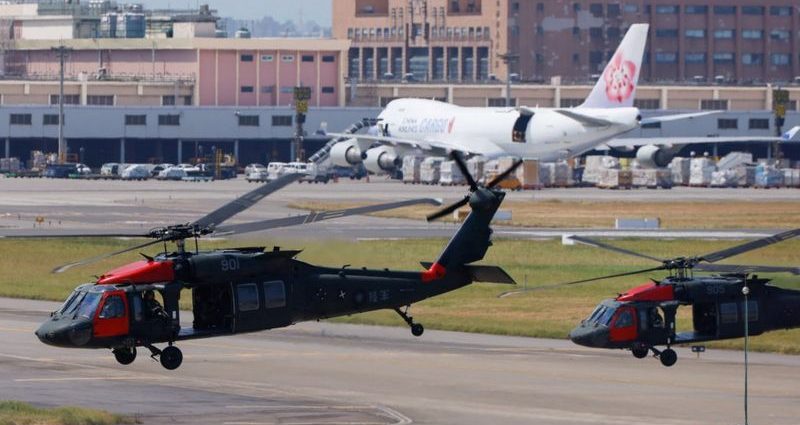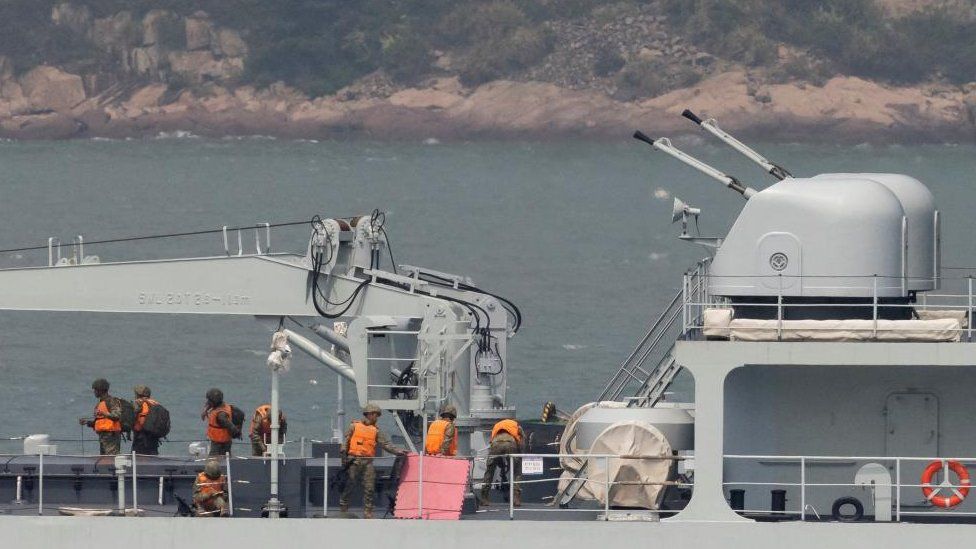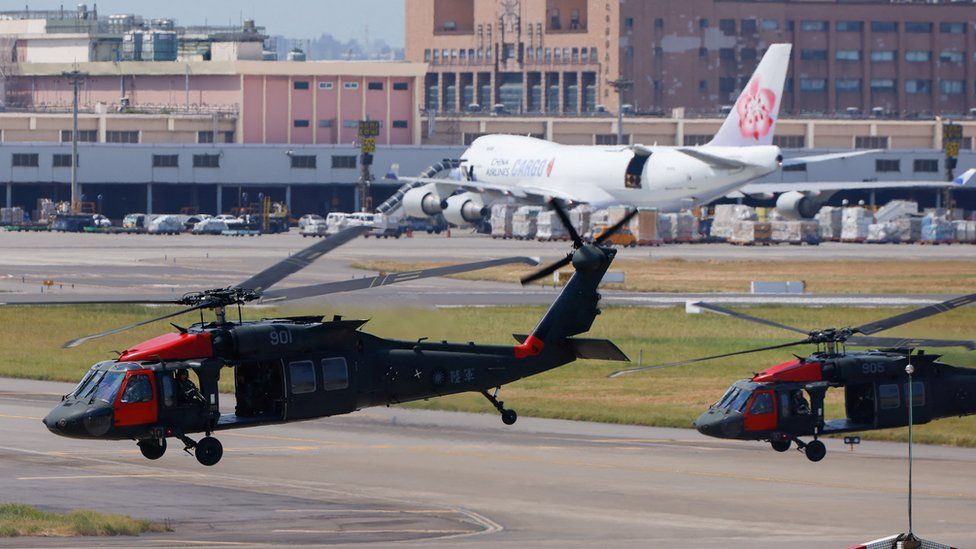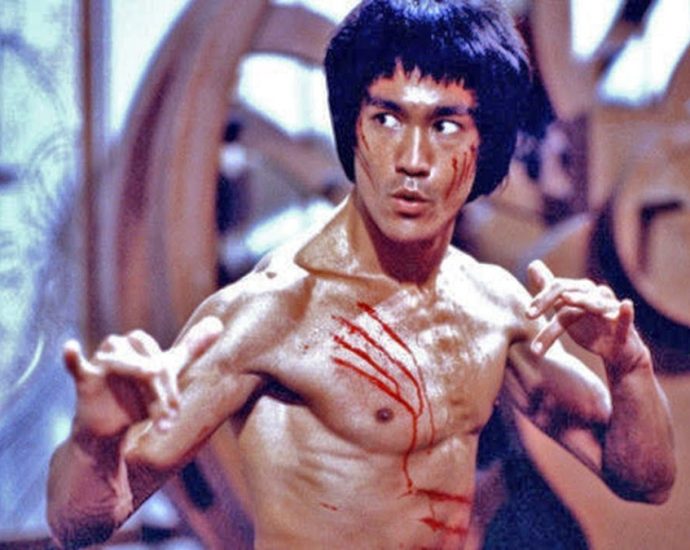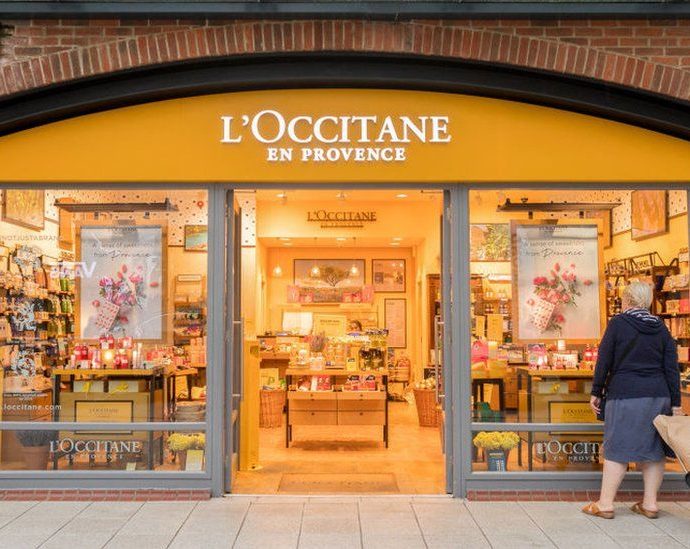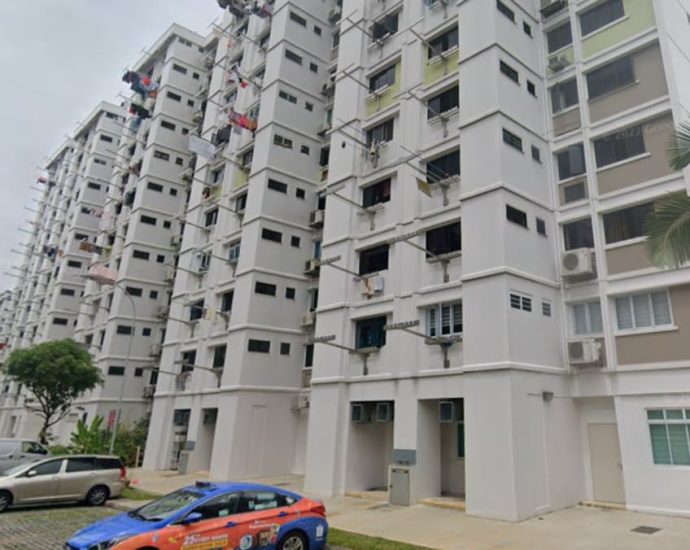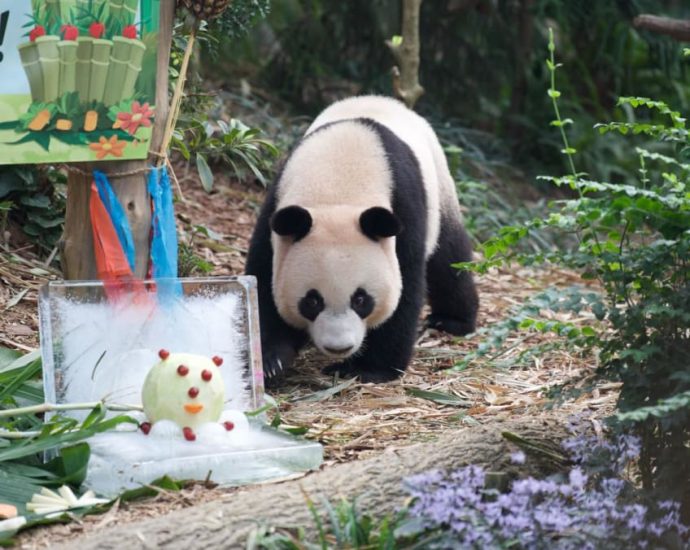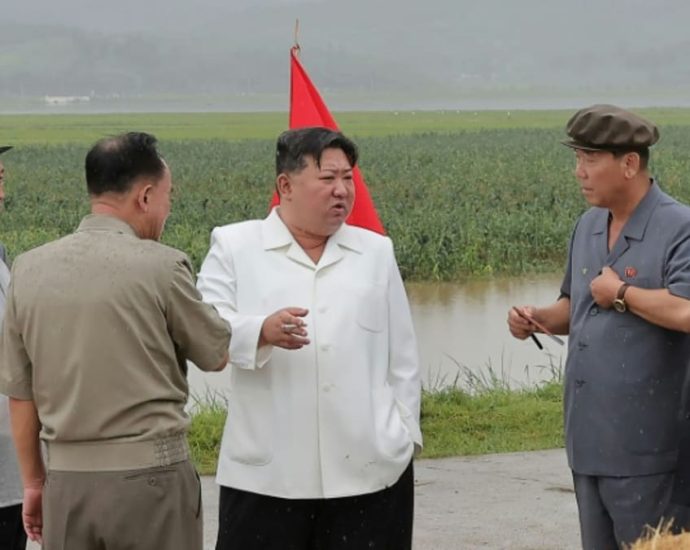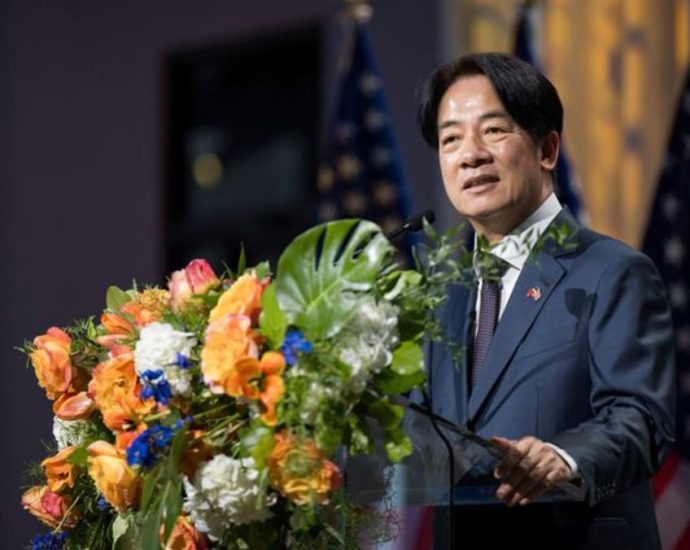Taiwan vice president is ‘troublemaker’, says Beijing
 Getty Images
Getty ImagesChina has called Taiwan’s vice president William Lai a “troublemaker” for his ongoing visit to the US.
Beijing firmly opposes any official contact between Taiwan, which it regards as a renegade province, and the United States.
Mr Lai is considered the frontrunner in next year’s presidential elections, which will take place in January.
Taiwan says Beijing will likely conduct military drills near the island this week in a bid to intimidate voters.
Mr Lai, 63, is officially on a transit stop in the US, whilst on his way to Paraguay to attend the inauguration ceremony of its new president. The South American nation is one of only 13 countries to have formal ties with Taiwan.
The presidential candidate of the ruling Democratic Progressive Party (DPP) was in New York and San Francisco over the weekend, where he gave a speech pledging to protect Taiwan’s sovereignty in the face of “authoritarianism”.
Mr Lai added that only Taiwan’s people can decide their future, and that Taiwan and China are “not subordinate to each other”.
He also stressed that he was “very willing” to talk to China to seek peace and stability – common rhetoric in the runup to the election, as candidates look to gather support without angering Beijing.
Mr Lai has previously called himself – to Beijing’s displeasure – a “pragmatic worker for Taiwanese independence”
In response, China’s foreign ministry denounced Mr Lai’s remarks and accused Washington of engaging the self-ruled island in political activities under the guise of a stopover.
Though the United States severed formal diplomatic ties with Taiwan in 1979, its leaders are allowed to make transit visits to the US.
Taiwan regards itself as distinct from mainland China, with its own laws and democratically elected leader.
However, Beijing sees it as a breakaway province that will eventually be brought under its control, by force if necessary.
In April, Beijing l conducted military drills in response to a meeting between Taiwanese president Tsai Ing-wen and US House Speaker Kevin McCarthy in California.
Experts have warned that Mr Lai’s remarks may further escalate tensions. US-China relations are at an all-time low, with Taiwan one of multiple flashpoints between the two sides.
Related Topics
Weâll always have Beijing

In the half-century since Bruce Lee’s early death in July 1973, the image of Chinese in Western culture and business has come full circle, with an added twist of spite.
Prior to the martial arts deity’s explosion on to cinema screens in the 1960s, Chinese men were barely seen except as anonymous hordes reminiscent of the wave warfare that kept America at bay in Korea.
Their ultimate sacrifice was presented in the West as an ant-like lack of humanity rather than the collective courage we recognize from the Allied storming of Normandy beaches.
Chinese characters who emerged from this human soup were instantly vilified as Yellow Peril, attributed with every hateful human trait. This malicious template returns periodically as Fu Manchu, Dr No, Emperor Ming the Merciless and other evil Chinese who step out of line.
It was “balanced” by lovable creatures like Charlie Chan (played by Swedish actor Warner Oland in eye tape); The Pink Panther’s comical Kato (Burt Kwouk, an actual East Asian) as a sidekick even more useless than his boss Inspector Clouseau, the most useless man on the planet; and also another Kato, sidekick this time to The Green Hornet in the TV series, played by an underused Bruce Lee. So much for American original thought and innovation.
The cycle for Chinese cultural representation through the geopolitical eras goes something like this: Opium Wars – bad; gold mining in California – weak; building the Central Pacific Railroad Road for low wages – good; going on strike for better wages and conditions on the CPRR – bad!; 1870s economic downturn in the US – really bad; 1882 Exclusion Act – GTFOH!; Boxer Revolution to the Republic of China – Yellow Peril; Warlord Thirties – well, ding, dong, Anna May Wong!; World War II – welcome, bro; 1949 – Wut?; Cold War Korea – here comes that ant wave; 1960s – the Blessed Bruce be upon us.
The swinging sixties was a great decade in which to be alive if you were a member of the postwar (preferably white) working and middle class in America, Britain or parts of Western Europe. Not so great if you were living in China and trying to rebuild your wrecked country while staring down the barrel of foreign embargoes and a messy Cultural Revolution.
Bruce Lee was born and raised in San Francisco. He was beautiful and graceful with a body sculpted like Roman marble, but most impressively, instead of submissiveness to the master race, he exuded pride in his Chinese origins. And, true to the cultural aspirations of the time, he stuck up for the little people rather than sticking it to them.
His divinity was felt keenly in the UK when his Hong Kong-made Kung Fu films came out in the 1970s, Enter the Dragon being their stunning apogee. Even my dad raised his head out of his books for long enough to praise this popular hero.
For the first time, young males in the West wanted to be like Lee, an Asian male, instead of wanting to kick him. Tough working-class lads of every hue sought out martial arts kwoons and dojos and stuck his posters on their walls. He was an inspiration to men of color, and they loved him for it.
If he hadn’t died on the cusp of the Nixon-Kissinger agreement with Mao that would propel China, ever so slowly, into a Golden Age, he’d probably have had his own movie empire on a par with Jackie Chan: JC to Lee’s John the Baptist.
In the glory years since China proved itself to be the rising superpower, Mandarin has been taught in schools and Beijing represented supreme cool. Ten Cent movies made mega-bucks. Marvel gave us Shang-Chi, the first superhero movie to star an Asian lead, and two Asian main characters in the Agents of Shield TV series, played by Ming-Na Wen and Chloe Bennet.
Benedict Wong and Gemma Chan escaped limited prospects in the UK and built solid careers in the Marvel universe and beyond, while Sandra Oh made the sole reverse journey across the Atlantic and busted out with Killing Eve. Michelle Yeoh was Everything, Everywhere All at Once from Crouching Tiger, Hidden Dragon to Star Trek. Asians were being normalized.
However, the screech of brakes and smell of burning rubber as the West performs a doughnut spin threatening to send positive images of Chinese crashing through the windshield, means all change.
How do you persuade the public that it’s OK to have a war with people they’ve been encouraged to identify with if you keep humanizing them? Are buddy movies with Chinese as equal partners doomed to history before we’ve finished our popcorn? Is whitewashed Doctor Strange about to morph into Dr Strangelove or be eclipsed by Fu Manchu redux?
The tension between an industry making bank in the two leading economies and the demand by China hawks to slaughter the Golden Goose has to be resolved somehow.
A promiscuous use of backfiring tariffs and sanctions may provide the very catalyst that transforms the greenback signs in oligarchal eyes into yuan, as dumping the global reserve currency accelerates and everyone stampedes for the exit.
One advantage China will always have in this wholly unnecessary contest is the US’s example of a modern Ozymandias: Behold my works, ye mighty, and de-dollarize. Never has America needed its original Eastern hero as much as now to explain the art of the martial to politicians who keep pristine copies of Sun Tzu’s The Art of War on display but never crack the spine.
You’re supposed to use the weight of your opponent against him, grasshopper. And Be Like Water doesn’t mean running into the berg that sinks the USS Titanic just becuz we can.
In 2018, the International Monetary Fund’s Christine Lagarde side-eyed president Donald Trump’s imposition of tariffs on Chinese goods, loudly announcing that we were finally emerging from a Certain Someone’s Great Crash of 2008 with Another Certain Someone’s help.
Wall Street had a conniption. Gary Cohn, Trump’s chief economic adviser, fumed, “Peter Navarro ratfucked us into a trade war with China by taking advantage of Trump’s very small brain.”
We watched aghast as, in the words of the British PM whose backbone hadn’t yet crumbled, Trump “let all the air out of the tires of the global economy.” (Including, presumably, Boris Johnson’s own family’s investments. We sincerely hope he was personally reimbursed after ripping out our Huawei 5G infrastructure at the behest of the First Certain Someone with maybe a loan or sumthin’.)
And now President Joe Biden triples down on the madness.
Ironic that the Kung Fu concept of your own actions rebounding and hurting you when you point a loaded finger and find three fingers pointing back has taken place in real-time in front of our eyes. Every poisonous character assassination, every fusillade of hurt ends up damaging the perp as the target slips further out of reach.
My Blu-ray of The Great Wall, perhaps the last of the Hollywood/China blockbuster lash-ups, arrived in 2018, two years after its 2016 release. Tainted by all the ensuing unpleasantness, it sits forlornly on a shelf, still in its shrink wrapper.
I may never find out how Matt Damon saved Chinese civilization. But we’ll always have Beijing.
Mekong water level falling
Thousands of rai of rice fields damaged
PUBLISHED : 14 Aug 2023 at 11:56

NAKHON PHANOM: The level of the Mekong river is falling and water can now be drained more quickly out of thousands of rai of flooded rice fields, authorities in this northeastern border province said on Monday.
The river was receding by 10-20 centimetres per day. It was measured at 10.70 metres deep on Monday morning, 1.30m below the spilling point of 12m, Irrigation officials said.
Although the Mekong is falling, water in three major tributaries – the Nam Oon, Nam Songkhram and Huay Bang Ko rivers – was 20-30% higher than their normal capacities.
The provincial irrigation office was trying to drain as much water as possible out of nearly 10,000 rai of rice fields which have been flooded. It was initially estimated about 5,000 rai of the flooded rice crop would be damaged.
LâOccitane shares jump as controlling shareholder mulls buyout
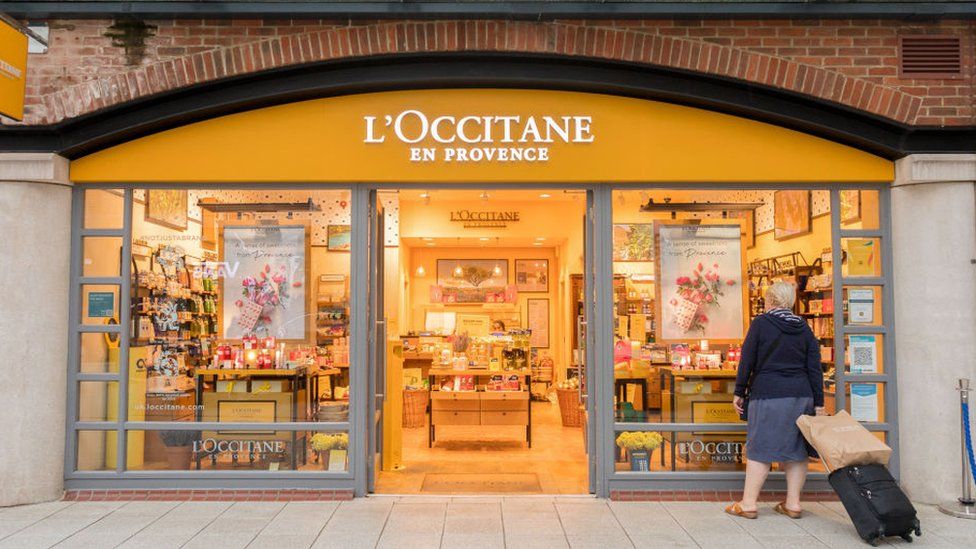 Getty Images
Getty ImagesShares in skincare chain L’Occitane International have jumped in trading on the Hong Kong Stock Exchange.
The global company confirmed on Friday that its controlling shareholder is contemplating a potential deal to take it private.
L’Occitane’s billionaire chairman Reinold Geiger already controls almost three quarters of its shares.
The retailer has over 3,000 outlets in 90 countries around the world and has more than 8,500 employees.
Trading in L’Occitane’s shares were halted on the Hong Kong Stock Exchange on Friday after Bloomberg News reported that Mr Geiger was in advanced talks to take it private.
The business news channel said that the potential deal could value the firm at around $6.5bn (£5.1bn), or as much as HK$35 ($4.47; £3.53) a share.
However, L’Occitane said in an exchange filing that reports that the buyout price could be that high were “false and without basis”, but if a deal did go through, the potential offer price would not be less than HK$26 a share.
Mr Geiger’s investment holding company, L’Occitane Groupe, owns more than 70% of the retailer.
L’Occitane’s shares were almost 9% higher at HK$27.75 in Monday morning trading in Hong Kong.
The company’s shares have risen by more than 40% in the last month.
L’Occitane’s latest annual financial report showed that it generated €2.13bn ($2.33bn; £1.84bn) in net sales and made an operating profit of €239.1m.
In April, the chain said it would close its Russian shops and website, just days after defending its decision to continue trading in the country.
The firm said the move followed the “enormous human suffering and escalating military action in Ukraine”.
The previous week L’Occitane had told the BBC that it was keeping its shops open to protect staff from potential “retaliation”.
Some customers had criticised the company for its decision and called for a boycott of the brand.
Related Topics
-
-
16 April 2022
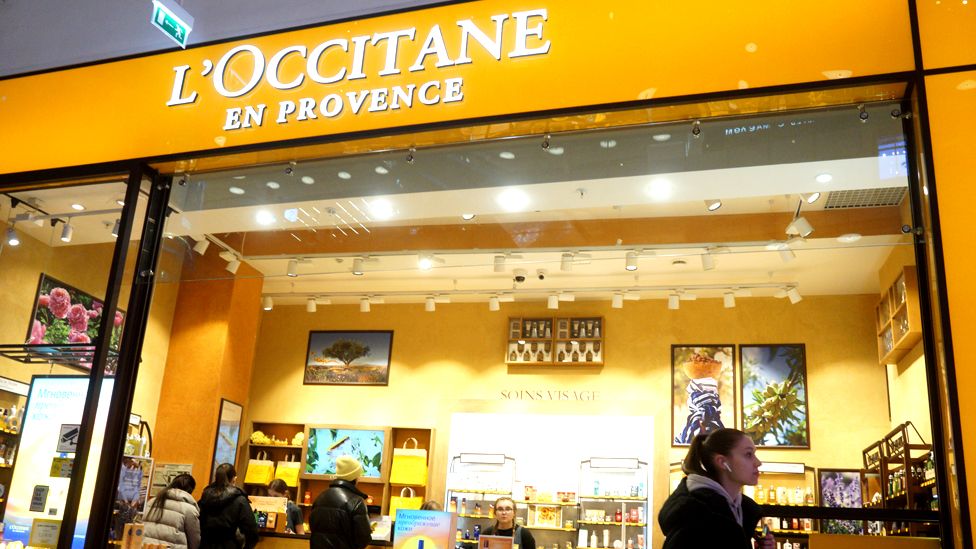
-
-
-
14 April 2022
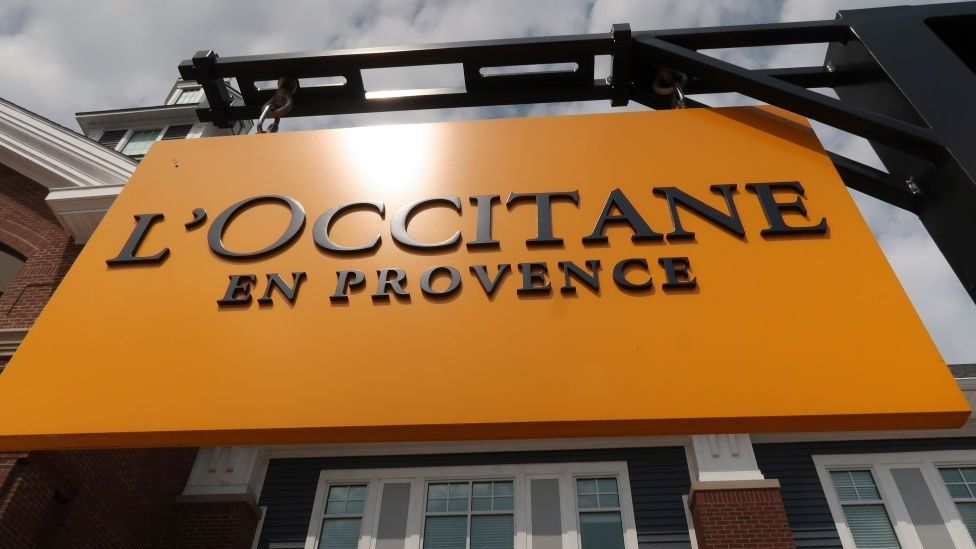
-
Typhoon Lan bears down on Japan’s main island
TOKYO: An approaching typhoon battered communities along Japan’s Pacific coast on Monday (Aug 14) with heavy rain and crashing waves, prompting authorities to warn about landslides and flooding. On track to hit the main island of Honshu early on Tuesday, Lan was expected to dump up to 40cm of rainContinue Reading
Woman whose body was found decomposing in HDB flat identified after fingerprint, DNA methods fail

SINGAPORE: A coroner’s court on Monday (Aug 14) confirmed the identity of a woman who was found dead in the kitchen toilet of her Housing Board flat, using circumstantial evidence after her fingerprints, DNA samples and dental records yielded dead ends.
Madam Tham Yoke Hing, 66, had no children or spouse and lived alone in a flat on the fourth floor at 48 Teban Gardens Road.
On Apr 21 this year, a neighbour living directly below her noticed water leaking from his ceiling and sought help from HDB officers to contact Mdm Tham.
Mdm Tham’s niece went down to the flat on Apr 23, after her uncle was notified of the issue, but was unable to get a response by knocking on the door.
She called the police for help that evening. Officers from the Singapore Civil Defence Force broke the door lock to gain entry with the permission of Mdm Tham’s family.
SCDF BREAKS INTO UNIT
They found Mdm Tham’s body lying in the kitchen toilet in a state of advanced decomposition.
The investigating officer on the case, Inspector Benjamin Sim, said he observed the floor to be wet and slimy when he went down to the scene.
Mdm Tham’s facial features were also “beyond recognition”, he said. There were no signs of ransack, forced entry or struggle, and valuables were intact in the unit.
“The police do not suspect any foul play, but due to the decomposed state of her body, the identity of the body needs to be ascertained,” he said.
Forensic specialists tried twice to lift thumbprints from the body, but were unable to because of the advanced state of decomposition.
Next, DNA was extracted from bone marrow taken from the body, and Mdm Tham’s older brother’s DNA samples were sent for DNA profiling.
However, the results showed that the pair were not biologically related, said INSP Sim. The DNA results did not match any existing DNA profiles in the system.
Mr Tham was interviewed and revealed that his sister was adopted.
A forensic pathologist from the Health Sciences Authority was consulted on using dental means to identify the body, but this was also a futile search as there were no teeth in the mouth and Mdm Tham had no dental records.
As the three primary means of identification – fingerprinting, DNA and dental records – were unsuccessful, INSP Sim said he had to rely on circumstantial evidence and accounts.
ACCOUNTS FROM NIECE AND NEIGHBOURS
Mdm Tham was last seen alive by neighbours about two to three weeks before her body was found.
One neighbour said he used to see her around 9am in the mornings when she went to the market.
Another neighbour said she had not seen Mdm Tham for over a month.
They said Mdm Tham lived alone in her flat and had no relatives or friends to visit her often.
Mdm Tham also did not like visitors because “of the state of her house”, INSP Sim noted.
Mdm Tham’s niece said the older woman usually wore a jade bangle and a metallic watch on her wrist, and the body found in the toilet bore these items, also on the wrist.
Medical records showed that Mdm Tham had chronic conditions, including diabetes, hypertension and osteoporosis.
Her cause of death was ascertained to be hypertensive heart disease, a natural disease process.
State Coroner Adam Nakhoda found that she had died of natural causes.
He added that Mdm Tham had not rented her flat to any tenants, nor did she have visitors. Thus, the body found in the flat could not have belonged to an unknown person, he said.
He confirmed that she was the person found dead in the unit, and extended his condolences to her next-of-kin.
China claims laser weapon gain on US space dominance
China has developed a new cooling system that allows high-energy lasers to operate infinitely without overheating, an innovation that could point a laser-sharp threat at US space dominance.
South China Morning Post (SCMP) reported that scientists from China’s National University of Defense Technology at Changsha, Hunan province, developed a new cooling system that eliminates the harmful heat generated by high-powered lasers, reportedly solving the overheating problem that has limited their operating time and performance.
SCMP notes that a laser weapon generates a high-energy beam using stimulated emission, which involves exciting atoms or molecules in a crystal or gas gain medium to a higher energy state.
When those excited atoms or molecules return to their ground state, they emit photons amplified by optical feedback to create a high-power laser beam, with a highly-precise beam control system directing and controlling the laser typically using mirrors and lenses.
As the beam passes through the air, it heats the gas in its path, causing it to expand and create a turbulent flow, making the beam scatter and distort, reducing its effectiveness and accuracy.
The heated gas can contaminate the mirrors and lenses in the system, degrading its performance and lifespan. In addition, larger pollutant particles burning on the mirrors can result in cracking or damage, reducing the practicability of high-energy laser weapons.
The Chinese science team claimed to have developed an internal beam conditioner that cools down the weapon and improves gas cleanliness.
According to the SCMP report, the system utilizes an air source to provide cool, dry air that flows through a heat exchanger, with gas at the optimum temperature regulated by a gas flow control system and injected into the laser beam path before being removed.
SCMP also noted some design challenges the research team encountered, such as ensuring that the gas flow achieved the desired cooling and cleaning effects, making the device compact and efficient enough for practical applications, and properly building the device to prevent turbulence and vibration from affecting beam quality.
Beijing Times noted the invention has several implications for the battlefield, which include extended engagement durations, amplified range and damage, and reduced maintenance and repair costs. The report also touts other advantages of laser weapons, such as instantaneous hits, negligible cost per shot and possible anti-satellite applications.
The Beijing Times report claims that previous US attempts to make high-power lasers into practical weapons, such as the Mid-Infrared Advanced Chemical Laser (MIRACL), Tactical High Energy Laser (THEL) and Airborne Laser (ABL), were eventually scrapped due to their unwieldy size and weight, unsatisfactory destructive power and relatively short range.
China’s internal beam conditioner may be a game-changer for its laser weapons program, especially for ground-based anti-satellite weaponry. For one, ground-based lasers have size, coverage and power advantages over airborne and satellite-mounted weapons.
They can destroy satellites with scalability and plausible deniability, as it is difficult to attribute a blinding laser attack on a satellite orbiting hundreds of kilometers above Earth at thousands of meters per second, as the temporary outage of a satellite could be accidental or the result of hard-to-detect aggression.

In May 2023, Asia Times reported that China may have built ground-based anti-satellite weaponry at its secretive Korla facility in Western Xinjiang, with such weapons intended to conceal sensitive military areas from spy satellites.
Satellite imagery of the Korla facility by US geospatial company BlackSky shows two laser gimbals mounted in hangars with retractable roofs that open around solar noon when foreign imaging satellites are most active.
The satellite imagery also shows huge anti-satellite lasers close to the size of ship-mounted weapons alongside domed structures, likely containing tanks for the gas required to operate the lasers.
Apart from the Korla site, China may have another such facility at Bohu in Xinjiang, with satellite imagery of the Bohu site showing fixed lasers for satellite ranging and mobile truck-mounted lasers for dazzling.
Apart from ground-based weapons, China may already have developed space-based laser weapons. Space-based weapons have several advantages over ground-based systems, such as the shorter distances between orbiting satellites and the lack of atmospheric distortion that degrades laser range and power.
Asia Times reported in March 2022 that China had developed a satellite-mountable solid-state pulse laser capable of generating a megawatt laser light and firing 100 times per second for half an hour without overheating in space.
It is reportedly capable of blinding satellite cameras or permanently blinding satellites. Upon testing, the device reportedly generated a five-nanosecond beam, but it was powerful enough to blind human beings or vaporize target surfaces permanently.
Recent advances in laser cooling technology, including a new cooling device made of copper and indium to absorb excess heat, reportedly made the weapon possible.
Despite those developments, China may still lag the US in other laser weapon areas. Asia Times noted in April 2023 that while China is adept at making smaller laser weapons, such as one possibly used in a February 2023 blinding laser attack against a Philippine Coast Guard (PCG) ship in the South China Sea, it lacks larger models that can intercept bigger targets such as missiles.
Both ground- and space-based laser weapons have drawbacks. Ground-based lasers require vast amounts of power to affect targets high in orbit and have atmospheric beam distortion and accuracy issues at great distances.

Space-based laser weapons face the challenge of developing a power source that is compact and powerful enough to be mounted on a satellite.
As such, China’s laser weapons program may be an asymmetric response to US space dominance, wherein the US exploits the space domain for strategic-level missile defense, intelligence and command and control, with its military and commercial satellites acting as early warning systems, eyes in the sky, or nerve centers for modern military operations.
The ongoing Ukraine war has vividly shown the decisive edge the US maintains in space dominance, with China possibly taking note for its Taiwan contingency plans.
Singapore’s first giant panda cub Le Le to be separated from mum as he turns two
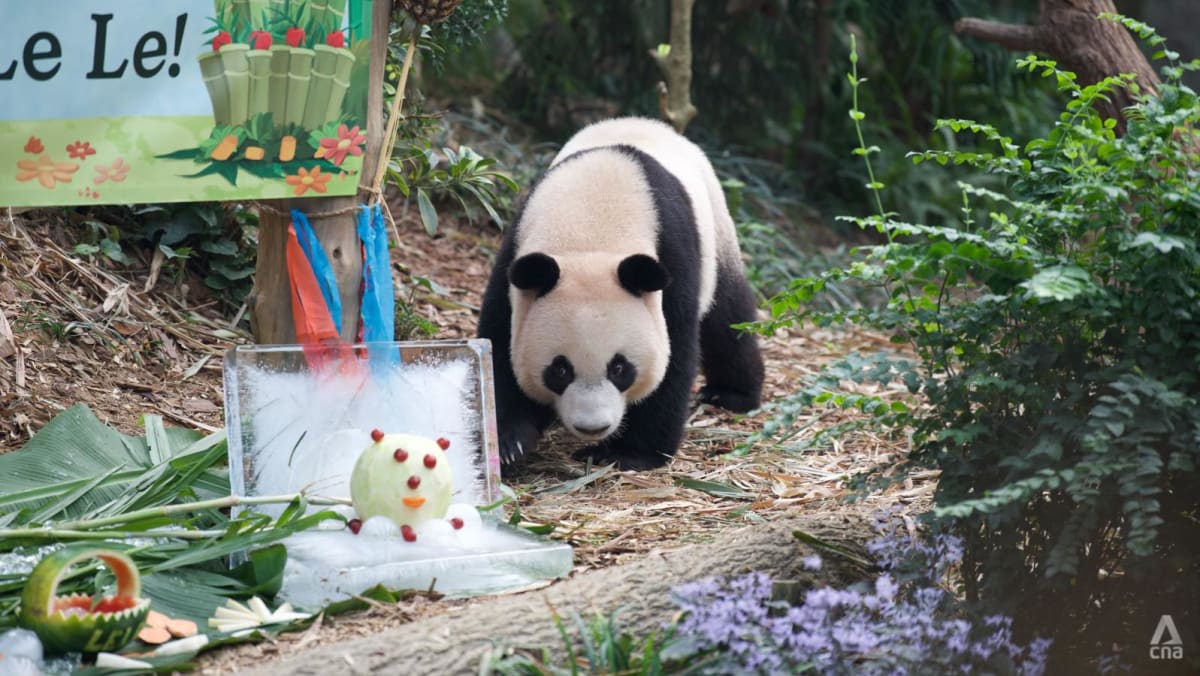
INDEPENDENCE PART OF “NATURAL PROCESS”
Le Le has been eating, resting and playing on his own, away from Jia Jia.
This is part of a “natural process” that mirrors what happens in the wild, when panda cubs become independent from about 18 to 24 months of age, Mandai added.
“They start displaying signs of being comfortable alone, while the mother pandas also begin to exhibit behavioural changes that lead to the eventual rejection of their cubs.”
As giant pandas are solitary animals, this life stage progression is part of growing up, Mandai said.
“As it is critical to assist the cub and mom safely through the separation, the animal care team has been conditioning Le Le to enter a new private den that is segregated from (his mum’s),” said Mandai, adding that this would empower him to live apart from Jia Jia when the time comes.
Full separation from Jia Jia is expected to occur in the coming months and the process will be closely monitored by the panda care team.
Once separation happens, Jia Jia and Le Le will split their time at their exhibit at the Giant Panda Forest in Mandai’s River Wonders park.
The public will be able to see Le Le from 10am to 2pm and Jia Jia from 2pm to 6pm.
Kim Jong Un berates North Korean officials over storm damage
SEOUL: North Korean leader Kim Jong Un berated “irresponsible” officials for failing to prevent damage from a tropical storm that swept through the Korean peninsula last week, state media said on Monday (Aug 14). Tropical Storm Khanun, which battered Japan before taking a circuitous route towards the Korean peninsula, movedContinue Reading
Taiwan will not back down to threats, says its vice president during US trip
China has a particular dislike of Lai, who has previously described himself as a “practical worker for Taiwan independence”, a red line for Beijing which has never renounced the use of force to bring the island under its control. Lai, who has pledged to maintain peace and the status quo,Continue Reading

